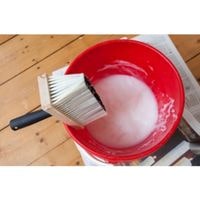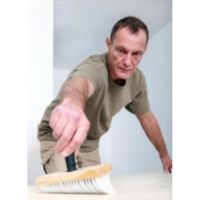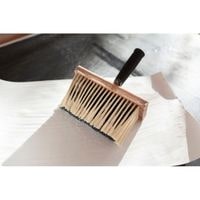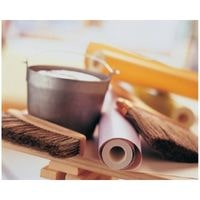How to make wallpaper paste. Wallpapering a room is a quick and easy way to redecorate. Today’s wallpaper patterns are endless, and most wallpaper is pre-pasted, meaning it doesn’t require any paste to put up.
However, if you’re wanting to make your own or use vintage or handmade paper then you’ll need to know how to make some homemade wallpaper paste so it’ll go on smoothly without wrinkles.
How to make wallpaper paste

About Making Wallpaper Paste: Add one cup of cornstarch to a large pot.
Add one gallon of hot tap water slowly, mixing thoroughly after each addition with a wire whisk.
Bring the mixture to medium-high temperature over the stove, keeping it on a gentle simmer and stirring constantly until it thickens and appears clear.
Some other methods are mentioned below in this post.
Making Starch Wallpaper Paste
Below are instructions on how to make wallpaper paste with starch.
Measuring Your Ingredients

Measure 10 cups of cold water into a large stock or soup pot, making sure you’ll have enough for the entire batch of wallpaper paste.
Scoop up 1 cup of dry, unmodified potato starch into a measuring cup, and set both items by your recipe book.
A typical amount for most recipes should prepare enough wallpaper paste to last the average homeowner a few months.
Put the pot on the stove & add Starch
Put the pot on the stove, but don’t turn on the heat yet. Add a few tablespoons of starch to the cold water and stir until they dissolve.
Put a lid on top of the pot, and increase the heat to high. Stir occasionally with a wooden spatula, then watch as it begins to boil.
Turn the heat to medium
Turn your stove burner to medium heat. Stir the starch water to break up any lumps that may be at the bottom of the pot, and then continue stirring for about 15 minutes; every 5 minutes is probably good, but it really depends on the environment you keep in your kitchen.
Look for thickening or lumps
To determine if the starch paste has thickened, scrape the bottom of the pot with a spatula to reach the stuck-on residue. Add water 1 tablespoon at a time until you feel resistance while stirring the mixture.
The paste is ready when it resembles a thick cake batter or pudding. Lift your spatula straight up from the pot to check for lumps in the paste.
If there are lumps present, turn down the heat and stir vigorously. Scrape down all lumps that remain in a paste and mix together in a food processor or blender to avoid clumped texture.
Take out the pot and stir the paste
Take the pot off the stove-top. The paste should be thick enough to hold a shape like that of a fun-shaped mold once cooled and ready to use.
Stir the paste for five more minutes until it’s at just the right consistency of being similar to a pudding or syrup.
It’s important to prime bare walls before hanging wallpaper and one of the best ways to ensure maximum adhesion is with a starch-based paste due to its ability to form strong, permanent bonds.
Often, you have some flexibility as to whether you can prime drywall or plaster prior to applying wallpaper paste and when it comes down to deciding which surface is best for application, things like their moisture levels tend to come into account.
For example, surfaces that are too moist or humid might not be ideal since they will slow the drying time for the paste which may cause issues with adhesion when applied. Additionally, painted surfaces can also act as a suitable primer for the wall.
Making Classic Wheat Wallpaper paste
The classic wheat wallpaper paste recipe that is preferred by many starts with preheating a pot which can be done either on the stove or in a microwave oven and adding 3 cups of water along with 5 cups of flour, stirring as you go.
Once the rough solution begins to simmer, either over a low flame on the stove or in the microwave’s glass carafe.
Drop down the temperature and let it cool for about an hour before allowing it to stand for somewhere between 24 hours and 48 hours. The finished paste will have a rather thick consistency/texture, like clear jelly.
Using your wallpaper paste

It’s advisable to use a wallpaper brush to apply a thin layer of paste over your wall. It’s best to apply wallpaper border or paper using a wallpaper roller.
Use a slightly dampened sponge and make sure the residue is entirely removed after you’re done applying the wallpaper or paper with your hands so as not to get it wet or inadvertently tear it.
It is recommended that stored paste be brought back to room temperature by adding just a little water and whisking the mixture until smooth before its next intended use because hot temperatures are said to affect the liquidity of paste mixtures.
How to make wallpaper paste
Related Guides
